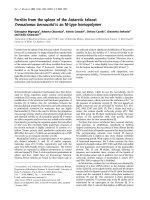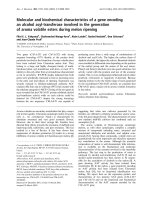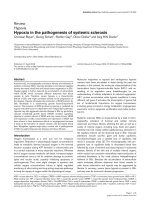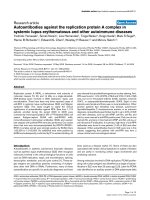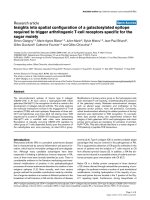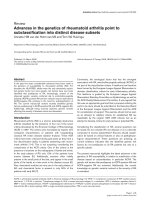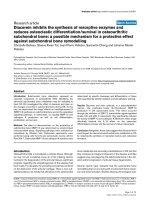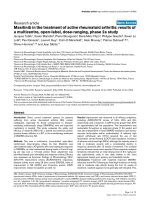Báo cáo y học: " Study protocol: the development of a randomised controlled trial testing a postcard intervention designed to reduce suicide risk among young help-seekers" ppsx
Bạn đang xem bản rút gọn của tài liệu. Xem và tải ngay bản đầy đủ của tài liệu tại đây (276.65 KB, 6 trang )
BioMed Central
Page 1 of 6
(page number not for citation purposes)
BMC Psychiatry
Open Access
Study protocol
Study protocol: the development of a randomised controlled trial
testing a postcard intervention designed to reduce suicide risk
among young help-seekers
Jo Robinson*, Sarah Hetrick, Sara Gook, Elizabeth Cosgrave, Hok Pan Yuen,
Patrick McGorry and Alison Yung
Address: ORYGEN Youth Health Research Centre, Department of Psychiatry, University of Melbourne Locked Bag 10, 35 Poplar Road, Parkville,
Victoria 3052, Australia
Email: Jo Robinson* - ; Sarah Hetrick - ; Sara Gook - ;
Elizabeth Cosgrave - ; Hok Pan Yuen - ; Patrick McGorry - ;
Alison Yung -
* Corresponding author
Abstract
Background: Suicidal behaviour and deliberate self harm are common among adolescents. Limited
evidence exists regarding interventions that can reduce risk; however research indicates that
maintaining contact either via letter or postcard with at-risk adults following discharge from
services can reduce risk. The aim of the study is to test a postcard intervention among people aged
15-24 who presented to mental health services but are not accepted, yet are at risk of suicide.
Methods/design: The study is a 3-year randomised controlled trial conducted at Orygen Youth
Health Research Centre in Melbourne Australia. Participants are young help-seekers aged 15-24
who are at risk of suicide. Participants will be recruited over a 12 month period. The intervention
comprises a regular postcard to be sent monthly for 12 months. The postcard enquires after their
well being and includes information regarding individual sources of help and evidence-based self
help strategies. Participants are assessed at baseline, 12 and 18 months.
Discussion: This paper describes the development of a study which aims to reduce suicide risk in
a sample of young help-seekers. If effective, this intervention could have significant clinical and
research implications for a population who can be hard to treat and difficult to research.
Trial Registration: The study was registered with the Australian Clinical Trials Registry; number:
ACTRN012606000274572.
Background
Suicidal and self-harming behaviour, including suicidal
ideation, are common amongst adolescents. Among sec-
ondary school students, approximately 5-7% report hav-
ing engaged in deliberate self-harm (DSH) in a 12 month
period, whilst lifetime rates are 12-13% [1,2]. As many as
60% reported suicidal ideation [3].
Suicidal behaviour, is associated with a range of negative
outcomes, most notably risk of further suicidal behaviour
Published: 23 September 2009
BMC Psychiatry 2009, 9:59 doi:10.1186/1471-244X-9-59
Received: 10 August 2009
Accepted: 23 September 2009
This article is available from: />© 2009 Robinson et al; licensee BioMed Central Ltd.
This is an Open Access article distributed under the terms of the Creative Commons Attribution License ( />),
which permits unrestricted use, distribution, and reproduction in any medium, provided the original work is properly cited.
BMC Psychiatry 2009, 9:59 />Page 2 of 6
(page number not for citation purposes)
and completed suicide [4,5] and other forms of premature
mortality such as accidental death and homicide [6]. A key
risk factor for suicidal behaviour is mental disorder [7],
particularly affective disorders and/or depressive symp-
toms [7,2]. However, mental disorders are not present in
all young people at risk and suicidal behaviour is often
precipitated by adverse life events or interpersonal crises
[7].
Whilst much is known about the epidemiology of suicidal
behaviour, less evidence exists regarding interventions to
reduce risk [8], particularly that from randomised-con-
trolled trials [9]. One promising intervention, tested in
adults, has a focus on maintaining contact with those at
risk. Two studies have shown that contact via regular letter
or postcard with at-risk adults, after discharge from an
inpatient psychiatric unit [10] or an Emergency Depart-
ment (ED) [11] reduced subsequent suicidal behaviour
for up to two years [10]. The treatment effect may be due
to enhancing connectedness and perceived social support
[12,11]. Treatment approaches that are successful among
adults may not be among young people [13] and it is
unknown whether the 'postcard' intervention would be
successful with adolescents and young adults.
Research at a specialist mental health service (ORYGEN
Research Centre, ORC) had showed that while a number
of young people were not unwell enough to meet the
entry criteria, this group included many individuals who
had made suicide attempts (n = 14; 25%) or expressed sui-
cidal ideation (n = 22; 38.6%) [14]. This highlighted a
service provision gap that could potentially be filled by a
postcard intervention.
Methods/design
Aims and hypotheses
The aims are to determine if suicidal and self harming
behaviour can be reduced by the receipt of a regular post-
card sent monthly over 1 year.
The hypotheses are that the receipt of a regular postcard
will result in: 1. Decreased suicidal behaviour and idea-
tion 2. A reduction in depression and hopelessness 3.
Improved self-esteem 4. Increased perceived social sup-
port, and 5. Increased help seeking. We further hypothe-
sise that: 6. There will be a positive association between
reductions in suicidal behaviour and improved self-
esteem and perceived support, and 7. Between reduced
suicidal behaviour and hopelessness and depression.
Study design
The study is a randomised controlled trial registered with
the Australian Clinical Trials Registry and approved by the
North Western Mental Health Research and Ethics Com-
mittee.
Setting
Orygen Youth Health (OYH) is a publicly funded special-
ist mental health service for people aged 15-24 living in
the Western and Northwestern regions of Melbourne. The
service treats individuals with both psychotic and non-
psychotic disorders. There is also a triage service, where
eligibility for treatment is determined. It also houses Ory-
gen Youth Health Research Centre (OYHRC).
Participants
Participants will be recruited from OYH triage over a 12
month period. Inclusion criteria are: 15 to 24 years; resi-
dent in Northwestern Metropolitan region of Melbourne;
refused from service; current or lifetime history of suicidal
ideation or attempts or DSH. These will be assessed by a
Research Assistant (SG) via the written triage records.
Exclusion criteria are: known organic cause for presenta-
tion; intellectual disability; inability to speak English. The
participant flow chart is shown in Figure 1.
Procedure
After assessing eligibility, the Research Assistant will tele-
phone the young person to explain the study and seek
informed consent. If the young person is interested in par-
ticipating, the Research Assistant will arrange a face-to-
face interview, during which written information will be
provided and consent sought. Once consent is obtained
the Research Assistant will conduct the baseline interview.
Following the baseline interview the study coordinator
(JR) will contact each participant by telephone (within 1
to 5 days), enquire about wellbeing and ask him or her to
identify 3 sources of help that may be useful in times of
crisis. It will be explained that this information would be
included in a postcard should the young person be allo-
cated to the intervention group.
Intervention
The intervention is a regular postcard sent in a sealed
envelope. One postcard a month is sent over 12 months,
starting the month after the baseline assessment. The post-
cards have been designed with a 'youth focus', in conjunc-
tion with the OYHRC consumer group. They all enquire
about the person's well being, remind them about the
sources of help identified during the telephone interview
and promote one of 6 evidence-based self-help strategies.
These are: 1. Physical activity 2. Early morning light expo-
sure 3. Self-help books based on cognitive behavioural
therapy 4. Websites known to be effective e.g. BluePages
[15] and Mood GYM [16] 5. Relaxation training 6. Reduc-
ing alcohol and other substance use [15-18]. The self-help
strategies and the individual sources of help will be
rotated. The participant's name and the individual source
of help obtained from telephone interview will be hand-
BMC Psychiatry 2009, 9:59 />Page 3 of 6
(page number not for citation purposes)
written and each postcard individually signed. An exam-
ple of the postcard is shown in Figure 2.
Included with each postcard will be a 'change of address'
slip, as well as the option for participants to request that
the postcards be discontinued.
Control intervention
Those in the control group will receive the initial 'sources
of help' interview but no postcards.
Outcomes
The primary outcomes are suicidal behaviour and idea-
tion, DSH, hopelessness, depression, self-esteem, help-
seeking and perceived social support, with assessment at
baseline, 12 and 18-months. The acceptability of the
intervention will also be assessed by calculating the pro-
portion of participants who choose to discontinue receiv-
ing the postcards and via an evaluation questionnaire
administered at 12-month follow-up. This questionnaire
also asks participants whether or not they had employed
any of the help-seeking strategies recommended in the
postcards.
Outcome measures
Basic demographic details, including age, gender, employ-
ment or educational status, living circumstances, country
of birth, parents' or guardians' employment status, par-
ents' or guardians' country of birth, medical history and
details of any treatment being received, are recorded on a
specifically designed, standardised questionnaire.
Axis-I diagnoses will be assessed using the Structured
Clinical Interview for DSM-IV [19].
Depression will be assessed by the Center for Epidemio-
logic Studies - Depression scale [20] a 20-item measure of
current level of depressive symptomatology. A cut off
score of 24 was used in this study in order to detect symp-
toms more likely to be of clinical significance [21].
The Beck Scale for Suicidal Ideation (BSS) [22] measures
suicidal ideation and intent. This is a 19 item self-report
scale with items rated on a 3-point scale (0-2). The total
score ranges from 0 to 38. Higher scores indicate greater
suicidal ideation.
The Brief Reason for Living Inventory - Adolescent Version
(BRFL-A) [23] is a self-report instrument that assesses sui-
cide ideation and behaviour. Higher scores, as rated on a
6-point scale (1 = not at all important to 6 = extremely
important), indicate greater reasons for living.
The Suicidal Behaviours Questionnaire (SBQ-14) [24]
measures five domains: past suicidal ideation, future sui-
cidal ideation, past suicide threats, future suicide
attempts, and the likelihood of dying in a future suicide
attempt. These domains are rated across a number of time
points: (1) the past several days including today, (2) past
month, (3) past four months, (4) past year, and (5) life-
time. The SBQ-14 also assesses the number of episodes of
DSH and suicide intent during the past year. In the present
study, this section of the questionnaire was modified to
assess lifetime and past month ratings of self-injurious
behaviour and suicide intent in order to provide more
specific information about chronicity and current risk of
suicidal behaviour.
The Beck Hopelessness Scale [25] measures hopelessness.
This is a 20-item true-false scale that measures the extent
of negative attitudes about the future. A total score is
Study flow-chart: This figure displays the participant flow-chartFigure 1
Study flow-chart: This figure displays the participant
flow-chart.
y
Patients aged 15-24 present to OYH triage with a
history of deliberate self harm, suicidal ideation or
suicide attempt but are NOT accepted into the
service
Research assistant reviews triage
notes and contacts those who meet
the stud
y
criteria & obtains consent
Baseline & sources of help
interviews conducte
d
Participants are randomised into
treatment & control groups by an
independent statistician
Treatment group receive a
postcard once a month for 12
months plus TAU
Control group receive
TAU
Followed up at 12 &
18 months
Followed up at 12 &
18 months
BMC Psychiatry 2009, 9:59 />Page 4 of 6
(page number not for citation purposes)
obtained by summing the ratings with a potential scoring
range of 0-20. High scores reflect greater hopelessness.
The Rosenberg Self-Esteem scale [26] is a 10-item measure
of global self-worth. Statements are rated on Likert scale
ranging from strongly agree (1) to strongly disagree (4),
with a total scale range of 10-40. Low versus high self
esteem was dichotomized using a cut-off score of 20, with
scores of below 20 indicating high self-esteem and scores
of 20 or above indicating low self-esteem.
The Multidimensional Scale of Perceived Social Support
[27] measures perceived social support. This 12-item
instrument includes items rated on a 7-point scale ranging
from "very strongly agree" to "very strongly disagree". The
total score ranges from 12-84 with a higher score indicat-
ing a greater level of perceived social support.
The General and Actual Help Seeking Scales [28] measure
help-seeking intentions, appraising both formal and
informal sources. Participants rate help-seeking inten-
tions ranging from 1 ("extremely unlikely") to 7
("extremely likely") for each help source option including
"no one". Higher scores indicate higher intentions. The
AHSQ measures actual help-seeking behaviour. In this
study participants were asked whether help had been
sought for "an emotional problem" within the last two
weeks. Generally, this measure is reported as three sub-
scales: whether or not informal help has been sought;
whether or not formal help has been sought; and whether
or not any help has been sought.
Sample size calculation: effect size and statistical power
Suicide and SA rates from other studies vary between 3.9%
and 15.1% for a contact group, and 4.6% and 17.3% for a
non-contact group [11,10], with small effect sizes. The
design of our study differs from previous studies and it is
not possible to make any firm inference for our study,
although it is reasonable to expect a similar effect size. The
power analysis for this study is based on using the general
linear model to compare the intervention and control
groups with the baseline values of an outcome measure as
the covariate. It is assumed (conservatively) that the cov-
ariate would explain 5% of the variance in the dependent
variable. Based on previous research at this centre, we
expect to recruit 180 subjects who would be equally allo-
cated to the two groups and conservatively estimated a
drop-out rate of 20%. A power calculation indicated that
Postcard: This figure contains an example of the postcard used in the studyFigure 2
Postcard: This figure contains an example of the postcard used in the study.
An example of the postcar d
'HDUBBBBBBBBBBB
,WKDVEHHQVRPHWLPHVLQFH\RXZHUHUHIHUUHGWR25<*(1<RXWK+HDOWKDQGDOWKRXJKZHZHUHQ·WDEOHWRRIIHU\RXDVHUYLF
H
ZHKRSH\RXDUHIHHOLQJEHWWHUDQGWKDWWKLQJVDUHJRLQJZHOO:KHQZHPHW\RXPHQWLRQHGWKDWJRRGVRXUFHVRIKHOSIRU\RXLQ
WLPHVRIFULVLVLQFOXGHBBBBBBBBBBB
<RXVKRXOGDOVRFRQVLGHUKRZSK\VLFDOO\DFWLYH\RXDUHDWWKHPRPHQW'LG\RXNQRZWKDWSHRSOHZKRDUHSK\VLFDOO\DFWLYHWHQG
WREHOHVVDQ[LRXVDQGGHSUHVVHG"7RJHWWKHEHQHILWVRISK\VLFDODFWLYLW\DOO\RXQHHGWRGRLVJRIRUDZDONIRUDWOHDVW
PLQXWHVDGD\7U\EXLOGLQJLWLQWR\RXUUHJXODUURXWLQH$ZDONRXWLQWKHVXQOLJKWHDUO\LQWKHPRUQLQJKHOSVWKHPRVW
2IFRXUVHLI\RXDUHLQQHHGRIIXUWKHUKHOSZHZRXOGEHYHU\KDSS\WRVHH\RXDJDLQDW25<*(1<RXWK+HDOWK
%HVWZLVKHVBBBBBBBBBBB
BMC Psychiatry 2009, 9:59 />Page 5 of 6
(page number not for citation purposes)
we would be able to detect a small effect size of 0.21 with
a significance level of 0.05 and power of 0.8. The actual
sample size (n = 165) has made only a small change to the
power calculation - the detectable effect size has increased
from 0.21 to 0.22.
Randomisation/treatment allocation
Random allocation to the postcard group and the control
group will be carried out by the independent statistician
(HPY), who has no knowledge about participants charac-
teristics, using blocked randomization and computer gen-
erated random numbers. This will be concealed from the
research team. The statistician will notify the study coor-
dinator regarding the group allocation. The study coordi-
nator will send out the postcards once per month.
The research assistant, who carries out the assessments,
will be blind to group allocation. The success of blinding
will be assessed at 18-months via questioning the research
assistant regarding whether they think the participant
received postcards as part of the RCT - Yes/No.
Statistical methods
At each follow-up time point the general linear model will
be used to test for the treatment factor, i.e. to compare the
intervention and control groups for each outcome meas-
ure. The corresponding baseline values of each outcome
measure will be used as the covariate. In addition, the
effects of other possible predictors (such as gender and
age) on outcome will be explored. Multi-level modeling
will be used to compare the trend over time for each out-
come in the two groups. Both the last observation carried
forward and multiple imputation techniques will be con-
sidered if the amount of missing values is substantial.
Safety and supervision
The research assistant received training in the administra-
tion of the measures and in the assessment of suicide risk.
The research assistant will make contact with the research
fellow (JR) overseeing the study once each assessment was
complete. If there is no cause for concern, contact will be
made via SMS. If there are concerns about the participant,
contact will be made by telephone or face-to-face and the
concerns will be discussed. If the research fellow is con-
cerned about the participant, an immediate referral will
be made to an appropriate service. Additionally, weekly
supervision meetings with an experienced clinical psy-
chologist (EC) will be held, during which all cases will be
presented and any diagnostic and/or risk issues discussed.
Any young people considered to be at elevated risk will be
referred to an appropriate service.
Discussion
This paper describes the protocol for a RCT that aims to
reduce suicide risk among young help-seekers. Although
much is known about the epidemiology of suicide in
young people, we know less about effective interventions,
and there are few studies that have successfully tested
interventions via an RCT [10]. One of the reasons for this
lack of evidence is that people at risk of suicide are often
excluded from trials because of the ethical implications of
denying treatment to this population [9]. However, if the
postcard intervention is shown to be effective it could be
used as a control treatment when testing other, more
intensive interventions, hence allowing an at-risk popula-
tion to participate in future trials. A further difficulty high-
lighted by previous research is that studies testing
interventions designed to reduce suicide risk are often
hampered by small sample sizes [11,29,10]. Again,
because of the nature of the postcard intervention, it could
be tested in large samples and in a range of settings.
If effective, this low-cost and transferable intervention has
the potential to reach large numbers of people who are
traditionally hard to engage in treatment. It is well docu-
mented that young people at risk of suicide are often non-
compliant with medication and frequently disengage
from services [30]. Therefore this intervention, whilst
clearly no substitute for treatment, may be a useful sup-
plement, or alternative when people refuse other forms of
treatment or do not meet the criteria for specialist care. It
could also be used following discharge from services, a
time when risk is known to be elevated [31].
Competing interests
The authors declare that they have no competing interests.
Authors' contributions
Authors JR, AY, PM and HPY were all involved in concep-
tion of the study and made substantial contributions to
the study design. In addition SG, EC made significant con-
tributions to acquisition of data, training and clinical
supervision. All authors have been involved in drafting
the manuscript and have seen and approved the final ver-
sion.
Acknowledgements
The authors would like to acknowledge Professor Jorm for his contribu-
tions to the study and Alison Hughes for her contribution to this manu-
script. This study is funded by a grant from the Australian Rotary Health
Research Fund. Orygen Youth Health Research Centre is affiliated with
Melbourne Health and the University of Melbourne, Department of Psychi-
atry and it receives funding from the Colonial Foundation and via a Program
Grant from the National Health & Medical Research Council.
References
1. De Leo D, Heller TS: Who are the kids who self-harm? An Aus-
tralian self-report school survey. Med J Aust 2004,
181(3):140-144.
2. Patton GC, Harris R, Carlin JB, Hibbert ME, Coffey C, Schwartz M, et
al.: Adolescent suicidal behaviours: a population-based study
of risk. Psychol Med 1997, 27(3):715-724.
Publish with BioMed Central and every
scientist can read your work free of charge
"BioMed Central will be the most significant development for
disseminating the results of biomedical research in our lifetime."
Sir Paul Nurse, Cancer Research UK
Your research papers will be:
available free of charge to the entire biomedical community
peer reviewed and published immediately upon acceptance
cited in PubMed and archived on PubMed Central
yours — you keep the copyright
Submit your manuscript here:
/>BioMedcentral
BMC Psychiatry 2009, 9:59 />Page 6 of 6
(page number not for citation purposes)
3. Harkavy-Friedman JM, Asnis GM, Boeck M, DiFiore J: Prevalence of
specific suicidal behaviors in a high school sample. Am J Psychi-
atry 1987, 144(9):1203-1206.
4. Owens D, Horrocks J, House A: Fatal and non-fatal repetition of
self-harm. A systematic review. Br J Psychiatry 2002,
181:193-199.
5. Suominen K, Isometsa E, Suokas J, Haukka J, Achte K, Lonnqvist J:
Completed suicide after a suicide attempt: a 37-year follow-
up study. Am J Psychiatry 2004, 161:562-563.
6. Hawton K, Fagg J: Suicide, and other causes of death, following
attempted suicide. Br J Psychiatry 1998, 152:359-366.
7. Beautrais A: Psychiatric illness in a New Zealand sample of
young people making serious suicide attempts. New Zealand
Medical Journal 1998, 111:44-48.
8. Robinson J, Pirkis J, Krysinska K, Niner S, Jorm AF, Dudley M, et al.:
Research priorities in suicide prevention in Australia. Crisis
2008, 29:180-190.
9. Goldney RD: Suicide prevention: a pragmatic review of recent
studies. Crisis 2005, 26:128-140.
10. Motto J, Bostrom A: A randomised control trial of post crisis
suicide prevention. Psych Services 2001, 52(6):828-833.
11. Carter GL, Clover K, Whyte IM, Dawson AH, C DE: Postcards
from the EDge project: randomised controlled trial of an
intervention using postcards to reduce repetition of hospital
treated deliberate self posioning. BMJ 2005,
331(7520):805-807.
12. Motto J: Suicide prevention for high-risk persons who refuse
treatment. Suicide Life Threat Behav 1976, 6:223-230.
13. Hazell P: Treatment strategies for adolescent suicide
attempters. In The International Handbook of Suicide and Attempted
Suicide Edited by: v Heeringen KH. Chichester: Wiley; 2000.
14. Cosgrave EM, Robinson J, Godfrey KA, Yuen HP, Killackey EJ, Baker
KD,
et al.: Outcome of suicidal ideation and behaviour in a
young help-seeking population over a 2-year period. Crisis
2007, 28:4-10.
15. Christensen H, Griffiths KM, Jorm AF: Delivering interventions
for depression by using the internet: randomised controlled
trial. BMJ 2004, 328:265.
16. Jorm AF, Griffiths KM: Population promotion of informal self-
help strategies for early intervention against depression and
anxiety. Psychol Med 2006, 36(1):3-6.
17. Jorm AF, Christensen H, Griffiths KM: Effectiveness of comple-
mentary and self-help treatments for anxiety disorders. Med
J Aust 2004, 181:S29-46.
18. Jorm AF, Christensen H, Griffiths KM, Rodgers B: Effectiveness of
complementary and self-help treatments for depression.
Med J Aust 2002, 176:S84-96.
19. First M, Spitzer R, Gibbon M, Williams J: Structured Clinical Inter-
view for DSM-IV-TR Axis I Disorders, Research Version,
Patient Edition (SCID-I/P). New York: Biometrics Research
Department, NY State Psychiatric Institute; 2002.
20. Radloff LS: The CES-D scale: A self-report depression for
research in the general population. App Psychol Measurement
1977, 1:385-401.
21. Roberts RE, Lewinsohn PM, Seeley JR: Screening for adolescent
depression - A comparison of depression scales. J Am Acad
Child, Adolesc Psychiatry 1991, 30(1):58-66.
22. Beck AT, Steer RA: Beck Scale for Suicidal Ideation: Manual.
San Antonio: The Psychological Corporation; 1993.
23. Osman A, Kopper BA, Barrios FX, Osman JR, Besett TM, Linehan
MM: The brief reasons for living inventory for adolescents
(BRFL-A). J Ab Child Psychol 1996, 24:433-443.
24. Linehan MM: Suicide Behaviours Questionnaire (SBQ). In
Unpublished instrument Seattle, WA: University of Washington; 1996.
25. Beck AT, Weissman A, Lester D, Trexler L: The measurement of
pessimism: The hopelessness scale. J Cons and Clin Psychol 1974,
42:861-865.
26. Rosenberg M: Society and the adolescent self-image. Princeton,
NJ: Princeton University Press; 1965.
27. Zimet GD, Dahlem NW, Zimet SG, Farley GK: The Multidimen-
sional Scale of Perceived Social Support. J Pers Assessment
1988, 52(1):30.
28. Wilson CJ, Deane FP, Ciarrochi J, Rickwood D: Measuring help-
seeking intentions: Properties of the General Help-Seeking
Questionnaire. Canadian J Counselling 2005, 39:15-28.
29. Hawton K, Townsend E, Arensman E, Gunnell D, Hazell P, House A,
van Heeringen K: Psychosocial versus pharmacological treat-
ments for deliberate self harm. Cochrane Database of Systematic
Reviews 1999:CD001764. DOI: 10.1002/14651858.CD001764
30. Hunt IM, Kapur N, Robinson J, Shaw J, Flynn S, Bailey H, et al.: Suicide
within 12 months of contact with mental health services in
different age and diagnostic groups. Br J Psychiatry 2006,
188:135-142.
31. Meehan J, Kapur N, Hunt IM, Turnbull P, Robinson J, Bickley H, et al.:
Suicide in mental health in-patients and within 3 months of
discharge. National clinical survey. Br J Psychiatry 2006,
188:129-134.
Pre-publication history
The pre-publication history for this paper can be accessed
here:
/>pub

